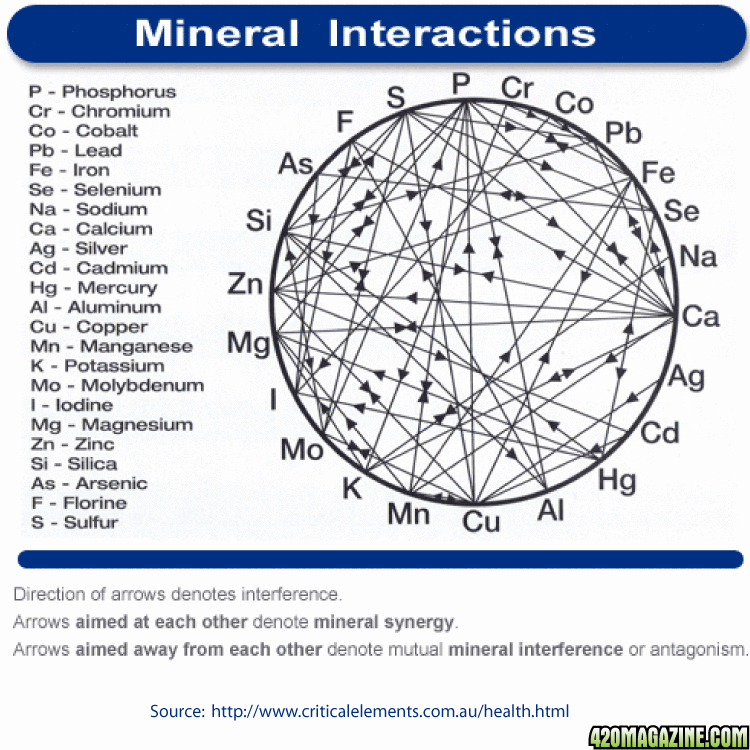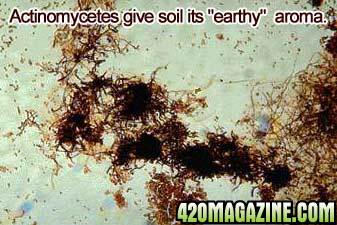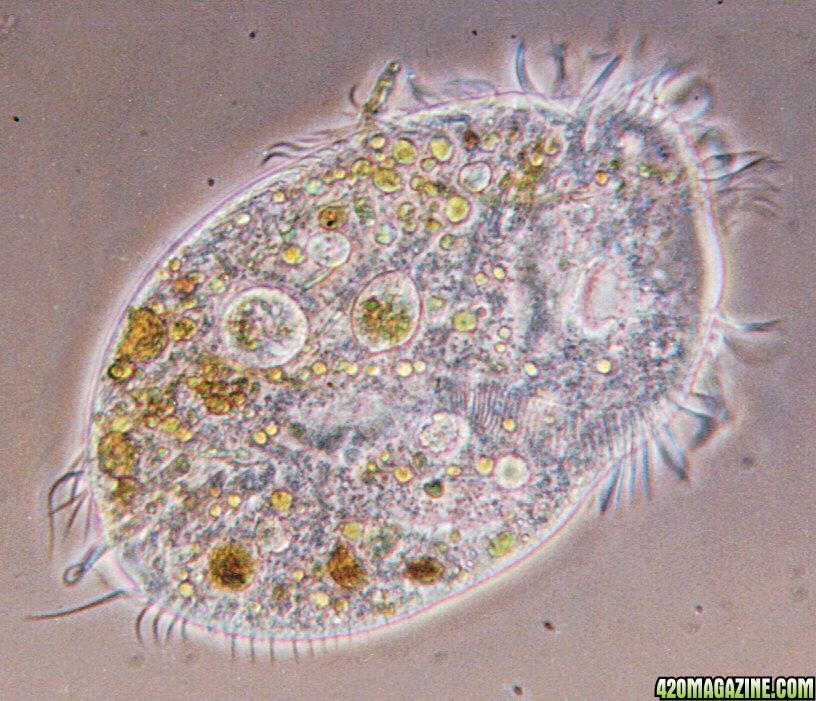We've been getting incredibly involved with organics this year, more then ever before.
As you can see from some of my threads within this section. I decided to make one thread and just keep it all together so we can wrap up this entire organic, biodynamic goodness!
To kick off the first post, let's discuss the soil food web. This is a large part of what is going on within any organic situation. It is the cycle of life at it's finest and fascinating to learn, comprehend, as well as share. If only school thought us about compost piles and engages the students with education rather then force them to read books, take tests, and homework.
Anyway, that's another conversation...
The soil food web is made of four organisms, from biggest to smallest (to my most recent knowledge EVERYONE chime in and lets create an amazing organic thread):
Nematodes
Protozoa
Fungi
Bacteria
These four things do wonders for your soil/root zone environment, just as mother nature intended. An easy way to think about all of this is to consider trees in a forest. How do they survive? No one is there watering them, checking pH, adding fertilizer, checking PPM etc. So how the hell do they grow? And all the other plants for that matter!?
This is what makes this entire subject of organic, biodynamic gardening absolutely amazing and fun!
Trees in a forest do not eat the leaves and braches that fall to the floor, they eat what the microbes make of them. Generally speaking when someone uses the term "microbes" they mean micro-organisms (living creatures), like nematodes, protozoa, fungi and bacteria.
I have gone over fungi in a large part already on the forum, here is the thread pertaining to that subject: Great Mycorrhiza Information
Now let's discuss bacteria, shall we?
Bacteria are absolutely tiny micro-organisms which do tons of things in this world.
Before we move further let's put everything into perspective. Generally speaking most scientists, biologists etc believe we've only scratched about 5-10% when it comes to what soil needs and all the fungi/bacteria involved. We still are finding new species, sometimes we may know more about the stars then everything on our own planet
There are many kinds of bacteria, some bacteria that we use in our gardens with products such as Great White are Nitrogen fixing bacteria. These microbes can take atmospheric nitrogen and turn it into available plant food nitrogen. Tell me that isn't absolutely amazing? Our atmosphere is 70% nitrogen which means there is plenty! So who needs some 10-0-0 fertilizer made in a lab when you have bacteria that will get the nitrogen for you the way mother nature intended?
The two common kinds of nitrogen fixing bacteria we will see is Azotobacter and Azospirillum.
Now consider how badass that is...then realize that's one element, Nitrogen. Imagine how many other things are going on down there!
Here is a link with some more information about other bacteria: https://www.plant-success.com/index.php/soil-bacteria-benefits/bacteria-species.html
Here is another good link with information about benefits of bacteria and fungi: https://www.plant-success.com/index.php/Overall-Benefits/overall-benefits.html (one reason we like Plant Success is they provide tons of documentation, not their just own but references)
Bacteria dominant soil tends to be above 7
Fungal dominant soil tends to be below 7
When speaking about Mycorrhizae products or in general the terms go as follows:
Mycorrhizal is an adjective describing the type of fungi
Mycorrhiza is a relationship between root and fungus
Mycorrhizae is the plural of a single root-fungus relationship
Now we're getting technical! I'm simply sharing information I am acquiring, please do the same!
Let's talk about Protozoa and Nematodes now. The circle of life is all about energy being distributed over and over. For example, in the wild a Gazelle can graze on grass to eat, giving it energy and minerals. Then it gets attacked by a predator who eats the Gazelle for energy and minerals (it gets passed on, even from that grass). Well then the predator eventually poops which is, once again, distributing energy and minerals into the ground. Spawning more grass that is grown, only to be eaten by another Gazelle. Whew, you better be high when you read this because it's a doozy!
This same concept goes on in our organic compost, soil and gardens. Things are regulated and energy is re-distributed constantly.
The protozoa and nematodes actually eat the bacteria and fungi. After processing them and pooping they provide by-product for the plants to use as energy. You don't want too much bacteria or fungi because they process food and also help bring it to your roots. However what if there is no food to process? That's where the protozoa and nematodes help out by adding that balance.
Protozoa Info: Protozoa - Wikipedia
Nematode Info: Nematode - Wikipedia
That is one very, very short synopsis on the soil food web.
Now discussing compost tea we can talk about helping all of those microbes thrive. When they thrive they live strong and reproduce, making more and more goodness for your plants benefit.
One very interesting thing I just recently learned was that Molasses will help encourage bacterial growth while Kelp will help encourage fungi growth. Not to say either will DISCOURAGE anything, it simply brings about more bacteria or fungi. Now with that knowledge you can make very specific compost teas because every plant has a different bacteria:fungi ratio in many cases.
We provide the most abundant compost tea solution we've ever found. Using a Vortex Brewer, which is an entire thread in and of itself. The tea we offer is extremely reliable and healthy, unlike others on the market. Our tea comes from a farm, not a lab first of all. Not to say labs are bad however if we are talking about natural, why not get it from a totally natural source?
Our tea comes from a 350 year old farm. Completely BioDynamic thriving with micro-biology!
If you're interested shoot me an e-mail joey@perfectgardens.com
We'll have it on the website very soon, I will reply with a link when I get it there.
So that's the beginning, let's get a great conversation going even further and share the knowledge so we all become better people to make a better planet!
As you can see from some of my threads within this section. I decided to make one thread and just keep it all together so we can wrap up this entire organic, biodynamic goodness!
To kick off the first post, let's discuss the soil food web. This is a large part of what is going on within any organic situation. It is the cycle of life at it's finest and fascinating to learn, comprehend, as well as share. If only school thought us about compost piles and engages the students with education rather then force them to read books, take tests, and homework.
Anyway, that's another conversation...
The soil food web is made of four organisms, from biggest to smallest (to my most recent knowledge EVERYONE chime in and lets create an amazing organic thread):
Nematodes
Protozoa
Fungi
Bacteria
These four things do wonders for your soil/root zone environment, just as mother nature intended. An easy way to think about all of this is to consider trees in a forest. How do they survive? No one is there watering them, checking pH, adding fertilizer, checking PPM etc. So how the hell do they grow? And all the other plants for that matter!?
This is what makes this entire subject of organic, biodynamic gardening absolutely amazing and fun!
Trees in a forest do not eat the leaves and braches that fall to the floor, they eat what the microbes make of them. Generally speaking when someone uses the term "microbes" they mean micro-organisms (living creatures), like nematodes, protozoa, fungi and bacteria.
I have gone over fungi in a large part already on the forum, here is the thread pertaining to that subject: Great Mycorrhiza Information
Now let's discuss bacteria, shall we?
Bacteria are absolutely tiny micro-organisms which do tons of things in this world.
Before we move further let's put everything into perspective. Generally speaking most scientists, biologists etc believe we've only scratched about 5-10% when it comes to what soil needs and all the fungi/bacteria involved. We still are finding new species, sometimes we may know more about the stars then everything on our own planet

There are many kinds of bacteria, some bacteria that we use in our gardens with products such as Great White are Nitrogen fixing bacteria. These microbes can take atmospheric nitrogen and turn it into available plant food nitrogen. Tell me that isn't absolutely amazing? Our atmosphere is 70% nitrogen which means there is plenty! So who needs some 10-0-0 fertilizer made in a lab when you have bacteria that will get the nitrogen for you the way mother nature intended?
The two common kinds of nitrogen fixing bacteria we will see is Azotobacter and Azospirillum.
Now consider how badass that is...then realize that's one element, Nitrogen. Imagine how many other things are going on down there!
Here is a link with some more information about other bacteria: https://www.plant-success.com/index.php/soil-bacteria-benefits/bacteria-species.html
Here is another good link with information about benefits of bacteria and fungi: https://www.plant-success.com/index.php/Overall-Benefits/overall-benefits.html (one reason we like Plant Success is they provide tons of documentation, not their just own but references)
Bacteria dominant soil tends to be above 7
Fungal dominant soil tends to be below 7
When speaking about Mycorrhizae products or in general the terms go as follows:
Mycorrhizal is an adjective describing the type of fungi
Mycorrhiza is a relationship between root and fungus
Mycorrhizae is the plural of a single root-fungus relationship
Now we're getting technical! I'm simply sharing information I am acquiring, please do the same!
Let's talk about Protozoa and Nematodes now. The circle of life is all about energy being distributed over and over. For example, in the wild a Gazelle can graze on grass to eat, giving it energy and minerals. Then it gets attacked by a predator who eats the Gazelle for energy and minerals (it gets passed on, even from that grass). Well then the predator eventually poops which is, once again, distributing energy and minerals into the ground. Spawning more grass that is grown, only to be eaten by another Gazelle. Whew, you better be high when you read this because it's a doozy!
This same concept goes on in our organic compost, soil and gardens. Things are regulated and energy is re-distributed constantly.
The protozoa and nematodes actually eat the bacteria and fungi. After processing them and pooping they provide by-product for the plants to use as energy. You don't want too much bacteria or fungi because they process food and also help bring it to your roots. However what if there is no food to process? That's where the protozoa and nematodes help out by adding that balance.
Protozoa Info: Protozoa - Wikipedia
Nematode Info: Nematode - Wikipedia
That is one very, very short synopsis on the soil food web.
Now discussing compost tea we can talk about helping all of those microbes thrive. When they thrive they live strong and reproduce, making more and more goodness for your plants benefit.
One very interesting thing I just recently learned was that Molasses will help encourage bacterial growth while Kelp will help encourage fungi growth. Not to say either will DISCOURAGE anything, it simply brings about more bacteria or fungi. Now with that knowledge you can make very specific compost teas because every plant has a different bacteria:fungi ratio in many cases.
We provide the most abundant compost tea solution we've ever found. Using a Vortex Brewer, which is an entire thread in and of itself. The tea we offer is extremely reliable and healthy, unlike others on the market. Our tea comes from a farm, not a lab first of all. Not to say labs are bad however if we are talking about natural, why not get it from a totally natural source?
Our tea comes from a 350 year old farm. Completely BioDynamic thriving with micro-biology!
If you're interested shoot me an e-mail joey@perfectgardens.com
We'll have it on the website very soon, I will reply with a link when I get it there.
So that's the beginning, let's get a great conversation going even further and share the knowledge so we all become better people to make a better planet!












